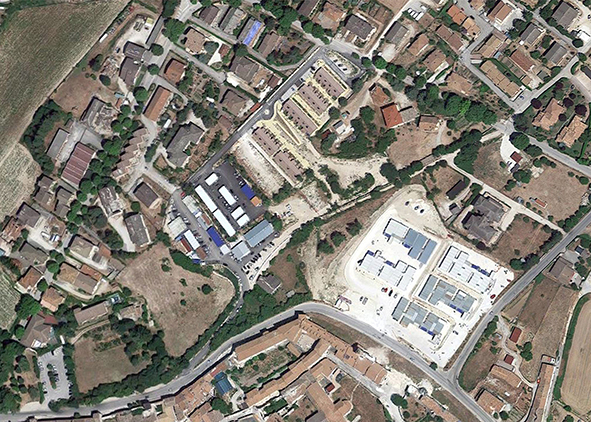Complementarity between permanent and temporary
DOI:
https://doi.org/10.19229/2464-9309/4102018Keywords:
temporary, permanent, architecture, emergency, meta-designAbstract
The article investigates the current role of temporary architecture as a logic to be considered no longer exceptional and contingent, but organic to the development and it proposes a reflection on the dialogue between the temporary and permanent dimension in architecture and urban planning projects with specific reference to interventions in response to housing emergency. Through the detection of the main critical issues persistent in recent earthquake events in Italy and through the proposal of synthetic meta-project applications, the article intends to provide an interpretation of a new relationship of complementarity between temporary interventions and preventive infrastructures of areas destined for emergency settlements in order to provide an adequate response to the new instances of sustainable development and resilient regeneration of the affected urban centers.
Downloads
Article Metrics Graph
References
Alberti, F. and Bologna, R. (2017), “Fruibilità e resilienza delle aree urbane di margine – Permanenza e temporaneità negli interventi di rigenerazione”, in XIX Conferenza Nazionale SIU, Cambiamenti – Responsabilità e strumenti per l’urbanistica al servizio del paese, Catania 16-18 Giugno 2016, Planum Publisher, Roma-Milano, pp. 845-850.
Antonini, E. and Tucci, F. (eds) (2017), Architettura, Città e Territorio verso la Green Economy, Edizioni Ambiente, Milano.
Baker, L. (2014), Temporary Architecture, Braun Publishing AG, Salenstein (CH).
Bishop, P. and Williams, L. (2012), The Temporary City, Routledge, London.
Bologna, R. and Terpolilli, C. (eds) (2005), Emergenza del Progetto – Progetto dell’Emergenza, Motta, Milano.
Decreto Legislativo 2 gennaio 2018 n. 1, Codice della protezione civile.
Dostoğlu, N., Eginöz, E. B., Kut, S. and Karacoç, E. (eds) (2016), Architecture in Emergency – Rethinking the refugee crisis, Proceedings, Istanbul Kültür University, Faculty of Architecture.
Foster, B. and Kodama, S. (2004), “Emergency management, recovery, and reconstruction following the 2002 Molise, Italy, Earthquake”, in Earthquake Spectra, vol. 20, n. S1, pp. 323-339.
Galante, P. (ed.) (2016), Migration and the Built Environment in the Mediterranean and the Middle East, Proceedings, Università degli Studi di Napoli 'Federico II'.
Guazzo, G. (2005), “Attualità dell’habitat temporaneo”, in Perriccioli, M. (ed.), La temporaneità oltre l’emergenza, Kappa, Roma.
Jodidio, P. (2011), Temporary Architecture Now!, Taschen, Köln.
Horden, R. (2004), “Microarchitecture: review of the past and future perspectives”, in Detail | Microarchitecture, n. 12, pp. 1422-1427.
Imperadori, M. (2007), “L’Armadillo: a new low-cost ready to built house system”, in Alexander, D., Davidson, C., Fox, A., Johnson, C. and Lizarralde, G. (eds), Post-disaster reconstruction – Meeting stakeholders interests, Firenze University Press, Florence.
Kronenburg, R. (2008), Portable Architecture – Design and Technology, Birkhauser, Basel.
Kronenburg, R. (2002), Houses in Motion – The Genesis, History and Development of the Portable Building, Wiley Academy, London.
Langenbach, R. and Dusi, A. (2004), “On the cross of Sant’Andrea: the response to the tragedy of San Giuliano di Puglia following the 2002 Molise, Italy, earthquake”, in Earthquake Spectra, vol. 20, n. S1, pp. 341-358.
Lizarralde, G., Davidson, C. and Johnson, C. (eds) (2010), Rebuilding after disasters – From emergency to sustainability, Taylor & Francis, London.
Moretti, A. (2014), “Prefazione”, in Bennicelli Pasqualis, M. G. (ed.), Case temporanee, Franco Angeli, Milano.
Presidenza del Consiglio dei Ministri, Dipartimento di Protezione Civile Nazionale (2015), Indicazioni operative inerenti la determinazione dei criteri generali per l’individuazione dei Centri operativi di coordinamento e delle Aree di emergenza. [Online] Available at: www.protezionecivile.gov.it/resources/cms/documents /Indirizzi_criteri_aree_emergenza_centri_coordinamento.pdf [Accessed 12 October 2018].
Presidenza del Consiglio dei Ministri, Dipartimento di Protezione Civile Nazionale (2007), Manuale operativo per la predisposizione di un piano comunale o intercomunale di protezione civile. [Online] Available at: www.protezionecivile.gov.it/resources/cms/documents/Manuale.pdf [Accessed 12 October 2018].
TAMassociati (2016), Taking care – Progettare per il bene comune, Becco Giallo, Padova.
United Nations International Strategy for Disaster Reduction (2007), The Hyogo Framework for Action 2005-2015, UNISDR, Geneva. [Online] Available at: www.unisdr.org/files/1037_hyogoframeworkforactionenglish.pdf [Accessed 12 October 2018].

Downloads
Published
How to Cite
Issue
Section
License
This Journal is published under Creative Commons Attribution Licence 4.0 (CC-BY).
License scheme | Legal code
This License allows anyone to:
Share: copy and redistribute the material in any medium or format.
Adapt: remix, transform, and build upon the material for any purpose, even commercially.
Under the following terms
Attribution: Users must give appropriate credit, provide a link to the license, and indicate if changes were made; users may do so in any reasonable manner, but not in any way that suggests the licensor endorses them or their use.
No additional restrictions: Users may not apply legal terms or technological measures that legally restrict others from doing anything the license permits.
Notices
Users do not have to comply with the license for elements of the material in the public domain or where your use is permitted by an applicable exception or limitation.
No warranties are given. The license may not give users all of the permissions necessary for their intended use. For example, other rights such as publicity, privacy, or moral rights may limit how you use the material.


















































































